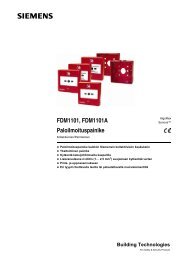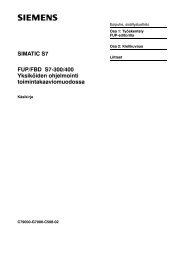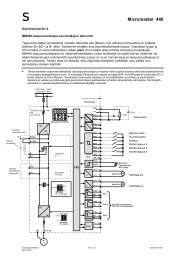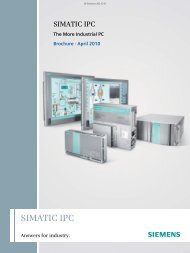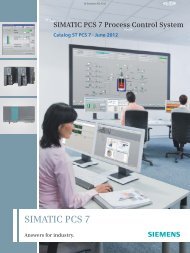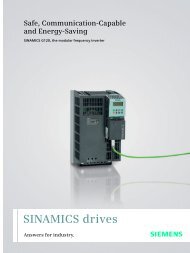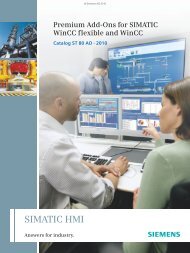Catalog LV 70 2011 - Low & Medium Voltage - Siemens
Catalog LV 70 2011 - Low & Medium Voltage - Siemens
Catalog LV 70 2011 - Low & Medium Voltage - Siemens
Create successful ePaper yourself
Turn your PDF publications into a flip-book with our unique Google optimized e-Paper software.
© <strong>Siemens</strong> AG <strong>2011</strong><br />
Appendix<br />
Isolating function<br />
(see also IEC/EN 60947-1; 2.1.19)<br />
Mechanical shock resistance<br />
Protection against accidental direct contact<br />
(see also EN 50274; 3.4)<br />
Positively-driven operation<br />
(see also IEC/EN 60947-1; 2.4.11 / IEV 441-16-12)<br />
Positive or<br />
enforced operation/actuation<br />
Positive opening<br />
(see also IEC/EN 60947-1; 2.4.10 / IEV 441-16-11)<br />
Safe isolation<br />
(see also IEC/EN 61140; 3.24)<br />
Tamper proof<br />
Type of coordination<br />
Utilization category<br />
(see also IEC/EN 60947-1; 2.1.18/IEV 441-17-19)<br />
(see also IEC/EN 60947-2; 4.4)<br />
Glossary<br />
Equipment is deemed to possess this isolating function provided their<br />
switching contacts, when in the open position, achieve the separation<br />
distance prescribed for the isolation of electrical circuits, and their<br />
clearance and creepage distances are of the required size. The<br />
power supply to the entire installation or a section of the installation can<br />
thus be cut off for safety reasons, e.g. during maintenance.<br />
The capacity of an equipment to withstand pulse-like motions without<br />
changing its operating state or sustaining damage. No contact lifting<br />
must take place on devices in the On position, the main contacts must<br />
not knock against one another in the Off position. A protective switch<br />
must not trip, and auxiliary switches must not change their switching<br />
state.<br />
Design measures incorporated into equipment in order to prevent<br />
direct contact (i.e. without tools) with live parts of a system (finger-safe,<br />
back-of-hand proof).<br />
This ensures that the auxiliary contacts of a switching device are<br />
always in the switch position corresponding to the open or closed position<br />
of the main contacts. The contacts of contactors are positively<br />
driven contacts, provided they are mechanically linked in such a way<br />
as to ensure that normally closed contacts and normally open contacts<br />
can never be closed simultaneously. This arrangement must also<br />
ensure that minimum contact separation of 0.5 mm is maintained over<br />
the entire endurance of the device, even during a fault (e.g. welding of<br />
one contact). The pertinent German Trade Association requires the use<br />
of contactors with positively driven contacts for control systems on<br />
power presses in the metal processing industry.<br />
This describes an arrangement where a link between the actuator and<br />
the contact ensures that the force exerted on the actuator is transferred<br />
directly (without the intervention of sprung parts) onto the contact.<br />
An opening operation which ensures that the main contacts of a switching<br />
device have attained the open position when the actuator is in the<br />
Off position.<br />
Isolation of circuits not carrying hazardous voltages, e.g. protective<br />
extra-low voltage, from circuits in which hazardous voltages flow. Such<br />
isolation is achieved by means of reinforced or double insulation, which<br />
reliably prevents voltage transfer from one circuit to another. This might<br />
otherwise take place between main circuits and auxiliary circuits in<br />
switching devices or between primary and secondary in safety transformers.<br />
Safe isolation is a priority requirement for safety circuits and<br />
functional low-voltage circuits.<br />
An EMERGENCY-STOP switching device is regarded as tamper<br />
proof provided it cannot be reset without tools or via prescribed procedure,<br />
after tripping has taken place. The device latches in the tripped<br />
position. Accidental or deliberate manipulation (inching) is ruled out.<br />
Status of a controlgear combination (motor starter) during and after<br />
testing at rated conditional short-circuit current:<br />
• Type of coordination 1:<br />
- no risk to persons or installations<br />
- no requirement for immediate readiness for renewed operation<br />
- damage to the starter is admissible<br />
• Type of coordination 2:<br />
- no risk to persons or installations<br />
- starter is capable of renewed operation<br />
- no damage to the starter with the exception of a slight welding of the<br />
switching contacts, provided they can be separated without significant<br />
deformation<br />
A combination of specified requirements relating to the operating condition<br />
in which the switching device or fuse fulfills its purpose, selected<br />
to represent a characteristic group of practical applications. The specified<br />
requirements may concern, for example, the values of making<br />
capacity, breaking capacity and other characteristic values, data concerning<br />
associated circuits, and the relevant conditions of use and<br />
operation characteristic.<br />
For circuit breakers, the utilization category denotes whether the equipment<br />
is designed for selectivity using time delay (category B) or not<br />
(category A).<br />
6<br />
<strong>Siemens</strong> <strong>LV</strong> <strong>70</strong> · 04/<strong>2011</strong><br />
6/3







